Abstract
1. The effect of chronic treatment with CI988, a recently developed selective antagonist of cholecystokinin type-B receptors (CCKB receptors) on the tolerance to morphine analgesia was studied in rats with the hot plate test. 2. Morphine tolerance was induced with the use of two paradigms. Morphine was injected i.p. either in a schedule of increasing doses (1-32 mg kg-1) twice daily for 6 days or at a fixed dose (3 mg kg-1) daily for 29 days. 3. In both series of experiments, tolerance to the analgesic effect of morphine was prevented by simultaneous treatment with i.p. CI988. Chronic treatment with only CI988 daily for up to 29 days did not reduce the analgesic effect of a weekly injection of morphine. 4. CI988 did not diminish the physical dependence to morphine, as examined with naloxone precipitated withdrawal. 5. The present results provide evidence that chronic treatment with a selective CCKB receptor antagonist could prevent tolerance to the analgesic effect of morphine without affecting morphine-induced physical dependence. Application of CCK antagonists may be clinically important in treating chronic pain patients by preventing morphine tolerance and by eliminating the need to increase morphine doses to unacceptable levels.
Full text
PDF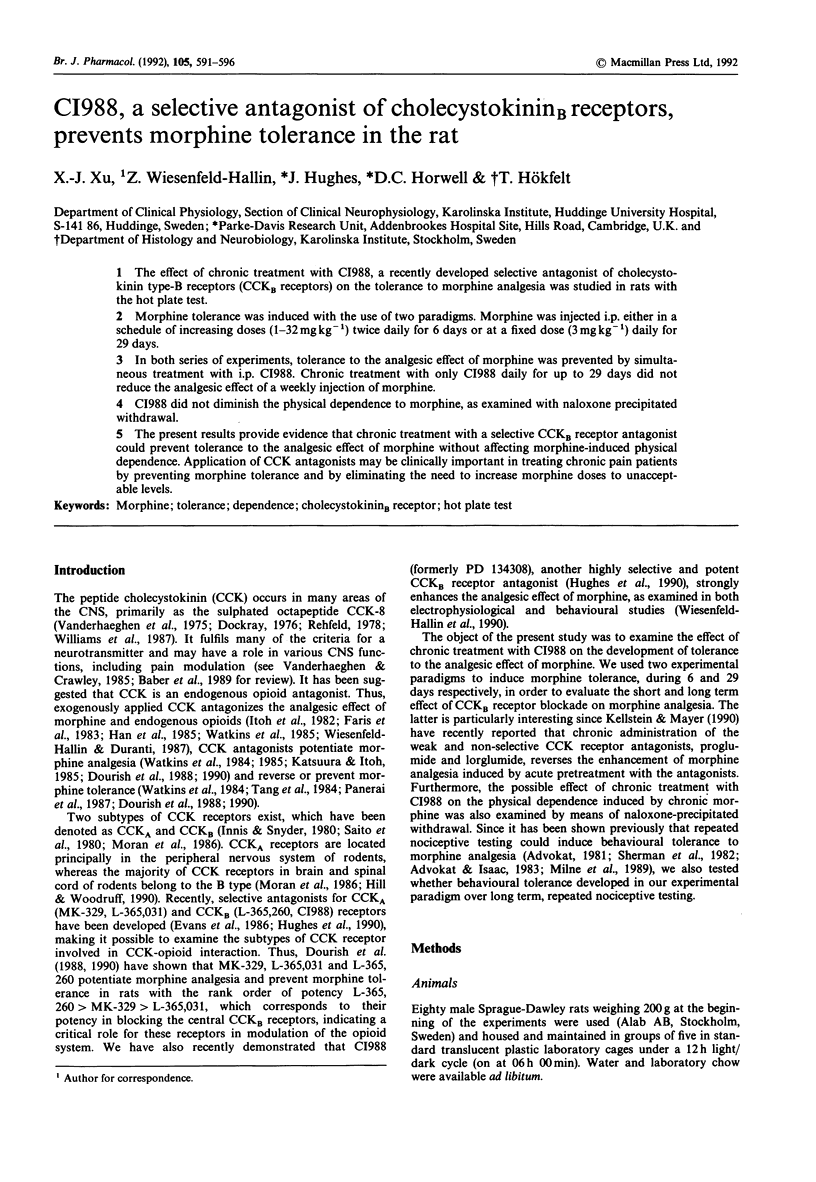
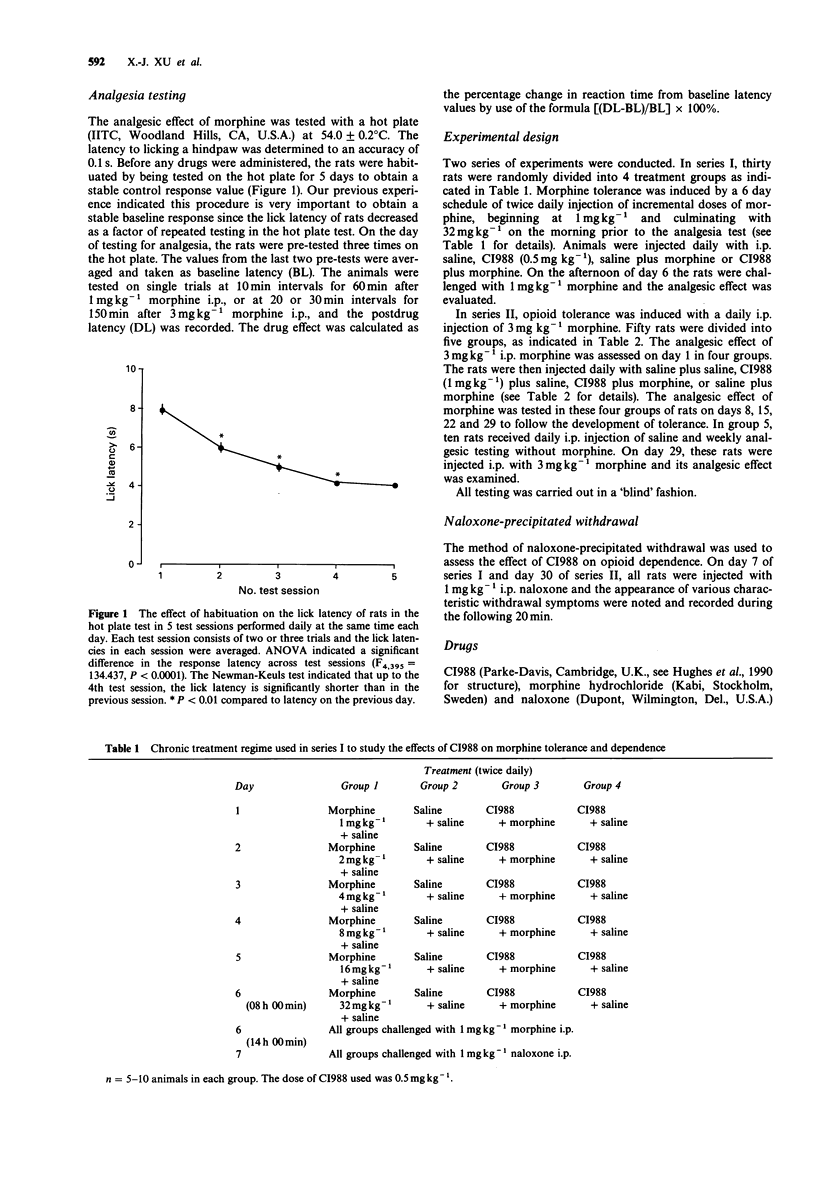
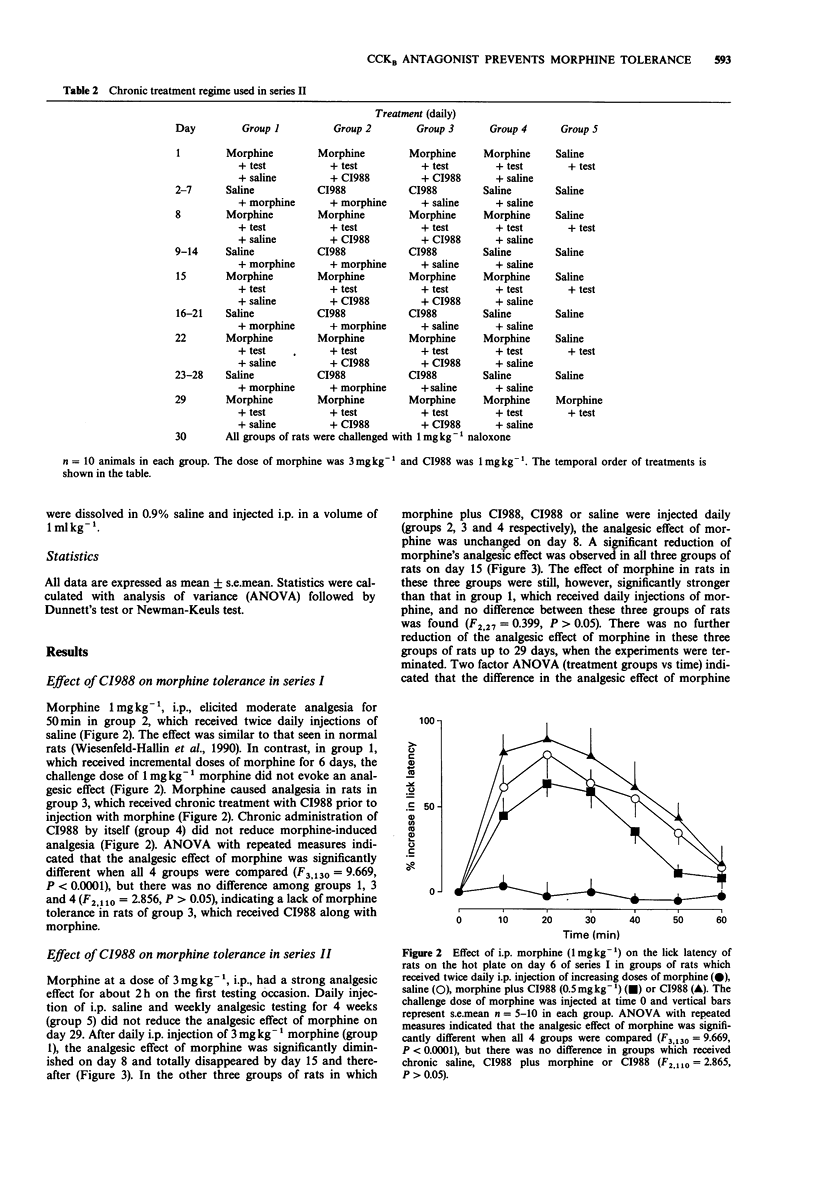

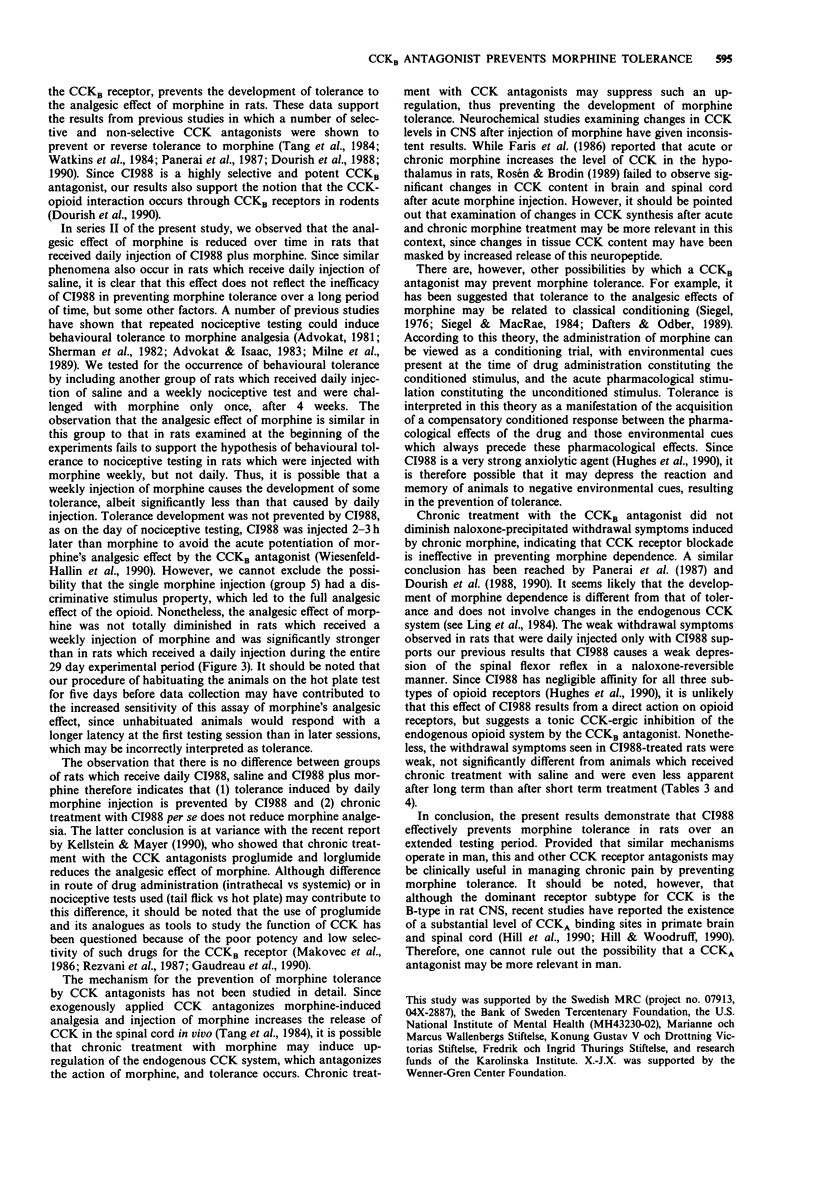
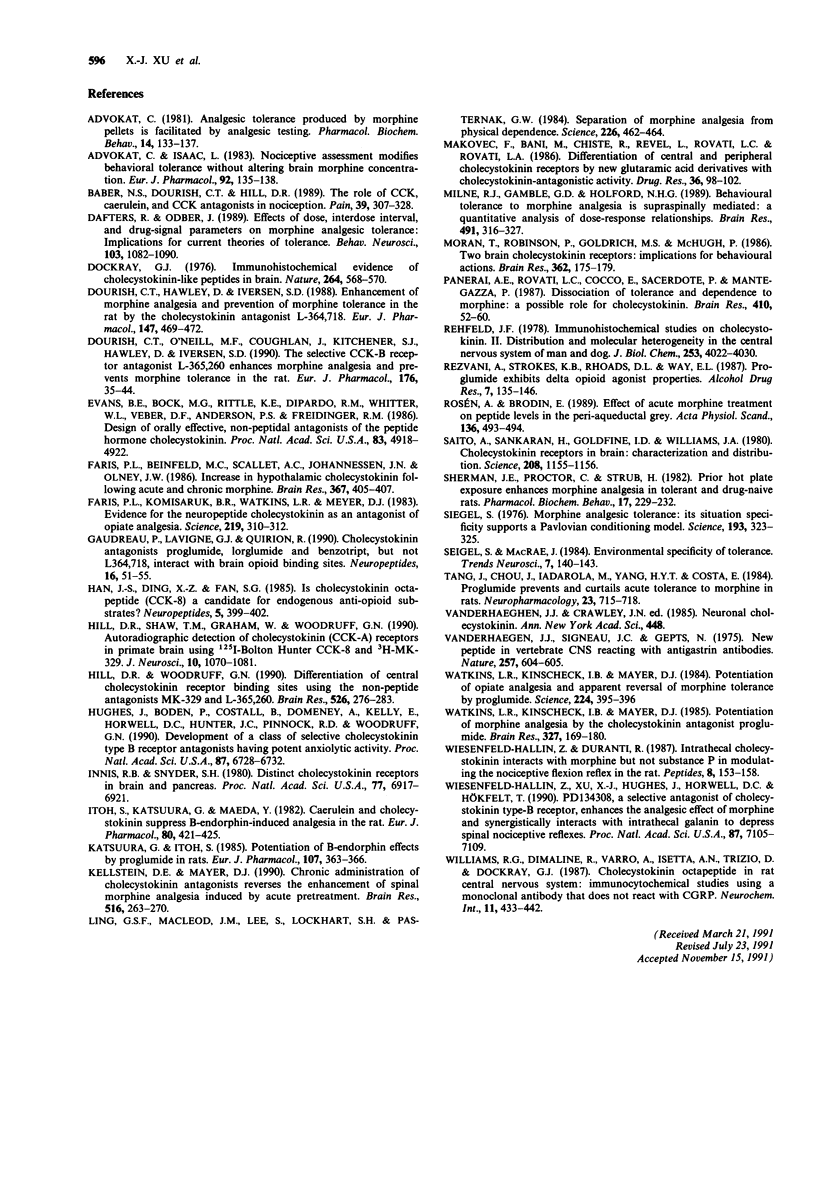
Selected References
These references are in PubMed. This may not be the complete list of references from this article.
- Advokat C. Analgesic tolerance produced by morphine pellets is facilitated by analgesic testing. Pharmacol Biochem Behav. 1981 Feb;14(2):133–137. doi: 10.1016/0091-3057(81)90232-x. [DOI] [PubMed] [Google Scholar]
- Advokat C., Isaac L. Nociceptive assessment modifies behavioral tolerance without altering brain morphine concentration. Eur J Pharmacol. 1983 Aug 19;92(1-2):135–138. doi: 10.1016/0014-2999(83)90119-x. [DOI] [PubMed] [Google Scholar]
- Baber N. S., Dourish C. T., Hill D. R. The role of CCK caerulein, and CCK antagonists in nociception. Pain. 1989 Dec;39(3):307–328. doi: 10.1016/0304-3959(89)90045-6. [DOI] [PubMed] [Google Scholar]
- Dafters R., Odber J. Effects of dose, interdose interval, and drug-signal parameters on morphine analgesic tolerance: implications for current theories of tolerance. Behav Neurosci. 1989 Oct;103(5):1082–1090. doi: 10.1037//0735-7044.103.5.1082. [DOI] [PubMed] [Google Scholar]
- Dockray G. J. Immunochemical evidence of cholecystokinin-like peptides in brain. Nature. 1976 Dec 9;264(5586):568–570. doi: 10.1038/264568a0. [DOI] [PubMed] [Google Scholar]
- Dourish C. T., Hawley D., Iversen S. D. Enhancement of morphine analgesia and prevention of morphine tolerance in the rat by the cholecystokinin antagonist L-364,718. Eur J Pharmacol. 1988 Mar 15;147(3):469–472. doi: 10.1016/0014-2999(88)90183-5. [DOI] [PubMed] [Google Scholar]
- Dourish C. T., O'Neill M. F., Coughlan J., Kitchener S. J., Hawley D., Iversen S. D. The selective CCK-B receptor antagonist L-365,260 enhances morphine analgesia and prevents morphine tolerance in the rat. Eur J Pharmacol. 1990 Jan 25;176(1):35–44. doi: 10.1016/0014-2999(90)90129-t. [DOI] [PubMed] [Google Scholar]
- Evans B. E., Bock M. G., Rittle K. E., DiPardo R. M., Whitter W. L., Veber D. F., Anderson P. S., Freidinger R. M. Design of potent, orally effective, nonpeptidal antagonists of the peptide hormone cholecystokinin. Proc Natl Acad Sci U S A. 1986 Jul;83(13):4918–4922. doi: 10.1073/pnas.83.13.4918. [DOI] [PMC free article] [PubMed] [Google Scholar]
- Faris P. L., Beinfeld M. C., Scallet A. C., Johannessen J. N., Olney J. W. Increase in hypothalamic cholecystokinin following acute and chronic morphine. Brain Res. 1986 Mar 5;367(1-2):405–407. doi: 10.1016/0006-8993(86)91629-x. [DOI] [PubMed] [Google Scholar]
- Faris P. L., Komisaruk B. R., Watkins L. R., Mayer D. J. Evidence for the neuropeptide cholecystokinin as an antagonist of opiate analgesia. Science. 1983 Jan 21;219(4582):310–312. doi: 10.1126/science.6294831. [DOI] [PubMed] [Google Scholar]
- Gaudreau P., Lavigne G. J., Quirion R. Cholecystokinin antagonists proglumide, lorglumide and benzotript, but not L-364,718, interact with brain opioid binding sites. Neuropeptides. 1990 May;16(1):51–55. doi: 10.1016/0143-4179(90)90029-x. [DOI] [PubMed] [Google Scholar]
- Han J. S., Ding X. Z., Fan S. G. Is cholecystokinin octapeptide (CCK-8) a candidate for endogenous anti-opioid substrates? Neuropeptides. 1985 Feb;5(4-6):399–402. doi: 10.1016/0143-4179(85)90038-1. [DOI] [PubMed] [Google Scholar]
- Hill D. R., Shaw T. M., Graham W., Woodruff G. N. Autoradiographical detection of cholecystokinin-A receptors in primate brain using 125I-Bolton Hunter CCK-8 and 3H-MK-329. J Neurosci. 1990 Apr;10(4):1070–1081. doi: 10.1523/JNEUROSCI.10-04-01070.1990. [DOI] [PMC free article] [PubMed] [Google Scholar]
- Hill D. R., Woodruff G. N. Differentiation of central cholecystokinin receptor binding sites using the non-peptide antagonists MK-329 and L-365,260. Brain Res. 1990 Sep 3;526(2):276–283. doi: 10.1016/0006-8993(90)91232-6. [DOI] [PubMed] [Google Scholar]
- Hughes J., Boden P., Costall B., Domeney A., Kelly E., Horwell D. C., Hunter J. C., Pinnock R. D., Woodruff G. N. Development of a class of selective cholecystokinin type B receptor antagonists having potent anxiolytic activity. Proc Natl Acad Sci U S A. 1990 Sep;87(17):6728–6732. doi: 10.1073/pnas.87.17.6728. [DOI] [PMC free article] [PubMed] [Google Scholar]
- Innis R. B., Snyder S. H. Distinct cholecystokinin receptors in brain and pancreas. Proc Natl Acad Sci U S A. 1980 Nov;77(11):6917–6921. doi: 10.1073/pnas.77.11.6917. [DOI] [PMC free article] [PubMed] [Google Scholar]
- Itoh S., Katsuura G., Maeda Y. Caerulein and cholecystokinin suppress beta-endorphin-induced analgesia in the rat. Eur J Pharmacol. 1982 Jun 4;80(4):421–425. doi: 10.1016/0014-2999(82)90089-9. [DOI] [PubMed] [Google Scholar]
- Katsuura G., Itoh S. Potentiation of beta-endorphin effects by proglumide in rats. Eur J Pharmacol. 1985 Jan 8;107(3):363–366. doi: 10.1016/0014-2999(85)90263-8. [DOI] [PubMed] [Google Scholar]
- Kellstein D. E., Mayer D. J. Chronic administration of cholecystokinin antagonists reverses the enhancement of spinal morphine analgesia induced by acute pretreatment. Brain Res. 1990 May 21;516(2):263–270. doi: 10.1016/0006-8993(90)90927-4. [DOI] [PubMed] [Google Scholar]
- Ling G. S., MacLeod J. M., Lee S., Lockhart S. H., Pasternak G. W. Separation of morphine analgesia from physical dependence. Science. 1984 Oct 26;226(4673):462–464. doi: 10.1126/science.6541807. [DOI] [PubMed] [Google Scholar]
- Makovec F., Bani M., Chisté R., Revel L., Rovati L. C., Rovati L. A. Differentiation of central and peripheral cholecystokinin receptors by new glutaramic acid derivatives with cholecystokinin-antagonistic activity. Arzneimittelforschung. 1986;36(1):98–102. [PubMed] [Google Scholar]
- Milne R. J., Gamble G. D., Holford N. H. Behavioural tolerance to morphine analgesia is supraspinally mediated: a quantitative analysis of dose-response relationships. Brain Res. 1989 Jul 10;491(2):316–327. doi: 10.1016/0006-8993(89)90066-8. [DOI] [PubMed] [Google Scholar]
- Moran T. H., Robinson P. H., Goldrich M. S., McHugh P. R. Two brain cholecystokinin receptors: implications for behavioral actions. Brain Res. 1986 Jan 1;362(1):175–179. doi: 10.1016/0006-8993(86)91413-7. [DOI] [PubMed] [Google Scholar]
- Panerai A. E., Rovati L. C., Cocco E., Sacerdote P., Mantegazza P. Dissociation of tolerance and dependence to morphine: a possible role for cholecystokinin. Brain Res. 1987 Apr 28;410(1):52–60. doi: 10.1016/s0006-8993(87)80019-7. [DOI] [PubMed] [Google Scholar]
- Rehfeld J. F. Immunochemical studies on cholecystokinin. II. Distribution and molecular heterogeneity in the central nervous system and small intestine of man and hog. J Biol Chem. 1978 Jun 10;253(11):4022–4030. [PubMed] [Google Scholar]
- Rezvani A., Stokes K. B., Rhoads D. L., Way E. L. Proglumide exhibits delta opioid agonist properties. Alcohol Drug Res. 1987;7(3):135–146. [PubMed] [Google Scholar]
- Rosén A., Brodin E. Effect of acute morphine treatment on peptide levels in the peri-aqueductal grey. Acta Physiol Scand. 1989 Jul;136(3):493–494. doi: 10.1111/j.1748-1716.1989.tb08692.x. [DOI] [PubMed] [Google Scholar]
- Saito A., Sankaran H., Goldfine I. D., Williams J. A. Cholecystokinin receptors in the brain: characterization and distribution. Science. 1980 Jun 6;208(4448):1155–1156. doi: 10.1126/science.6246582. [DOI] [PubMed] [Google Scholar]
- Sherman J. E., Proctor C., Strub H. Prior hot plate exposure enhances morphine analgesia in tolerant and drug-naive rats. Pharmacol Biochem Behav. 1982 Aug;17(2):229–232. doi: 10.1016/0091-3057(82)90074-0. [DOI] [PubMed] [Google Scholar]
- Siegel S. Morphine analgesic tolerance: its situation specificity supports a Pavlovian conditioning model. Science. 1976 Jul 23;193(4250):323–325. doi: 10.1126/science.935870. [DOI] [PubMed] [Google Scholar]
- Tang J., Chou J., Iadarola M., Yang H. Y., Costa E. Proglumide prevents and curtails acute tolerance to morphine in rats. Neuropharmacology. 1984 Jun;23(6):715–718. doi: 10.1016/0028-3908(84)90171-0. [DOI] [PubMed] [Google Scholar]
- Vanderhaeghen J. J., Signeau J. C., Gepts W. New peptide in the vertebrate CNS reacting with antigastrin antibodies. Nature. 1975 Oct 16;257(5527):604–605. doi: 10.1038/257604a0. [DOI] [PubMed] [Google Scholar]
- Watkins L. R., Kinscheck I. B., Mayer D. J. Potentiation of morphine analgesia by the cholecystokinin antagonist proglumide. Brain Res. 1985 Feb 18;327(1-2):169–180. doi: 10.1016/0006-8993(85)91511-2. [DOI] [PubMed] [Google Scholar]
- Watkins L. R., Kinscheck I. B., Mayer D. J. Potentiation of opiate analgesia and apparent reversal of morphine tolerance by proglumide. Science. 1984 Apr 27;224(4647):395–396. doi: 10.1126/science.6546809. [DOI] [PubMed] [Google Scholar]
- Wiesenfeld-Hallin Z., Duranti R. Intrathecal cholecystokinin interacts with morphine but not substance P in modulating the nociceptive flexion reflex in the rat. Peptides. 1987 Jan-Feb;8(1):153–158. doi: 10.1016/0196-9781(87)90179-3. [DOI] [PubMed] [Google Scholar]
- Wiesenfeld-Hallin Z., Xu X. J., Hughes J., Horwell D. C., Hökfelt T. PD134308, a selective antagonist of cholecystokinin type B receptor, enhances the analgesic effect of morphine and synergistically interacts with intrathecal galanin to depress spinal nociceptive reflexes. Proc Natl Acad Sci U S A. 1990 Sep;87(18):7105–7109. doi: 10.1073/pnas.87.18.7105. [DOI] [PMC free article] [PubMed] [Google Scholar]


